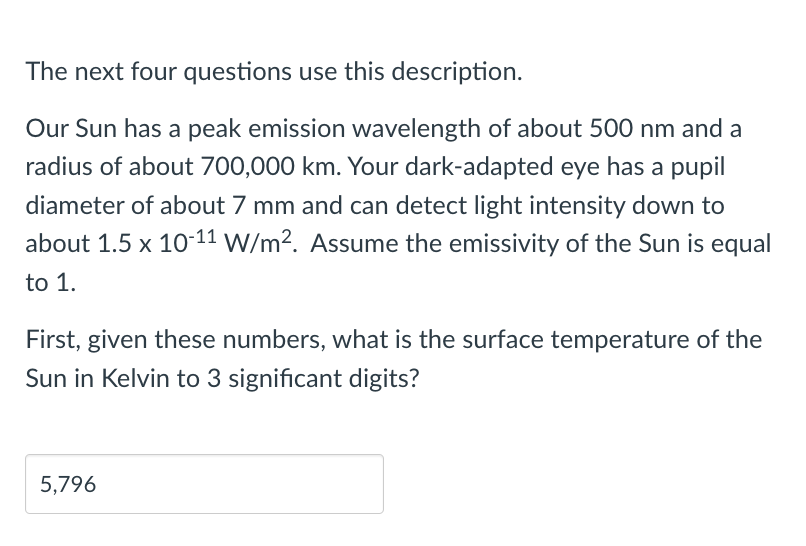The next four questions use this description. Our Sun has a peak emission wavelength of about 500 nm and a radius of about 700,000 km. Your dark-adapted eye has a pupil diameter of about 7 mm and can detect light intensity down to about 1.5 x 10-11 W/m². Assume the emissivity of the Sun is equal to 1. First, given these numbers, what is the surface temperature of the Sun in Kelvin to 3 significant digits? 5,796
The next four questions use this description. Our Sun has a peak emission wavelength of about 500 nm and a radius of about 700,000 km. Your dark-adapted eye has a pupil diameter of about 7 mm and can detect light intensity down to about 1.5 x 10-11 W/m². Assume the emissivity of the Sun is equal to 1. First, given these numbers, what is the surface temperature of the Sun in Kelvin to 3 significant digits? 5,796
Physics for Scientists and Engineers: Foundations and Connections
1st Edition
ISBN:9781133939146
Author:Katz, Debora M.
Publisher:Katz, Debora M.
Chapter19: Temperature, Thermal Expansion And Gas Laws
Section: Chapter Questions
Problem 39PQ
Related questions
Question

Transcribed Image Text:The next four questions use this description.
Our Sun has a peak emission wavelength of about 500 nm and a
radius of about 700,000 km. Your dark-adapted eye has a pupil
diameter of about 7 mm and can detect light intensity down to
about 1.5 x 10-11 W/m². Assume the emissivity of the Sun is equal
to 1.
First, given these numbers, what is the surface temperature of the
Sun in Kelvin to 3 significant digits?
5,796
Expert Solution
This question has been solved!
Explore an expertly crafted, step-by-step solution for a thorough understanding of key concepts.
This is a popular solution!
Trending now
This is a popular solution!
Step by step
Solved in 2 steps

Follow-up Questions
Read through expert solutions to related follow-up questions below.
Follow-up Question

Transcribed Image Text:To ignite a mixture of gasoline and air inside an internal combustion engine--like in your
car--a spark is generated by a high voltage across the spark plug, usually in the 10's of
thousands of volts, but the battery is only 12 V. This massive increase in voltage is
achieved through a transformer called the 'ignition coil'. A typical ignition coil has a primary
with 300 turns wrapped around a radius of 2 cm over a linear distance of 15 cm. The
secondary has 60,000 turns of wire over the same cylinder. The spark is generated when
the current is suddenly shut off to the coil. Assuming that the magnetic field is uniform
inside the primary and secondary coils, and that all of the magnetic field lines that go
through the primary go through the secondary, what voltage is generated in the secondary
coil if the current in the primary coil drops from 10 A to 0 A at a steady rate over the
course of 50 mirco-seconds? Give your answer to 2 significant digits.
Hint: Remember the definition of flux and how it can change, and remember how to
calculate the magnetic field of a coil of wire.
Typically, I'd walk you through a problem of this complexity; here I'm flexing your ability to
put multiple pieces together on your own.
Solution
Knowledge Booster
Learn more about
Need a deep-dive on the concept behind this application? Look no further. Learn more about this topic, physics and related others by exploring similar questions and additional content below.Recommended textbooks for you

Physics for Scientists and Engineers: Foundations…
Physics
ISBN:
9781133939146
Author:
Katz, Debora M.
Publisher:
Cengage Learning


Principles of Physics: A Calculus-Based Text
Physics
ISBN:
9781133104261
Author:
Raymond A. Serway, John W. Jewett
Publisher:
Cengage Learning

Physics for Scientists and Engineers: Foundations…
Physics
ISBN:
9781133939146
Author:
Katz, Debora M.
Publisher:
Cengage Learning


Principles of Physics: A Calculus-Based Text
Physics
ISBN:
9781133104261
Author:
Raymond A. Serway, John W. Jewett
Publisher:
Cengage Learning

Physics for Scientists and Engineers with Modern …
Physics
ISBN:
9781337553292
Author:
Raymond A. Serway, John W. Jewett
Publisher:
Cengage Learning